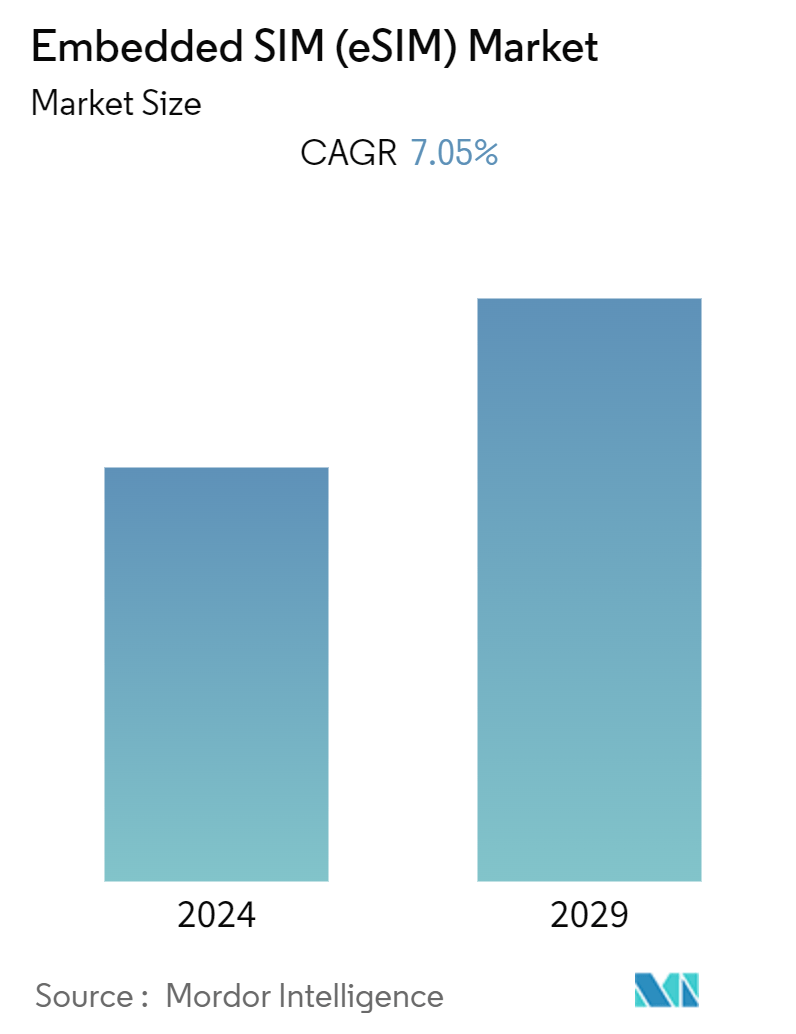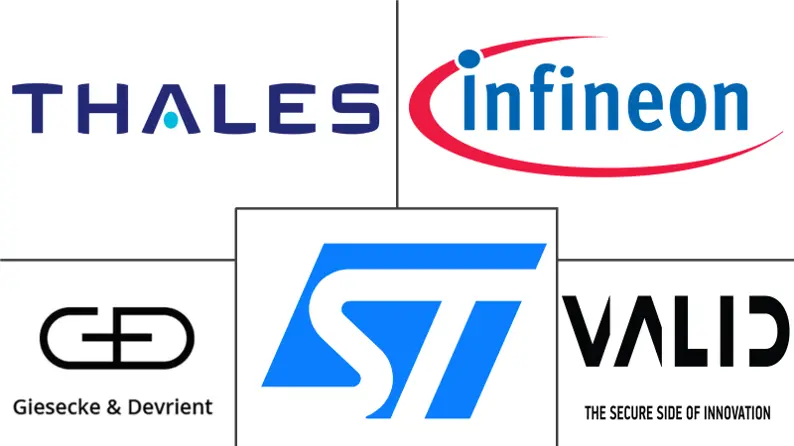Market Size of Embedded SIM (eSIM) Industry

| Study Period | 2019 - 2029 |
| Base Year For Estimation | 2023 |
| CAGR (2024 - 2029) | 7.05 % |
| Fastest Growing Market | Asia Pacific |
| Largest Market | North America |
| Market Concentration | Low |
Major Players
*Disclaimer: Major Players sorted in no particular order |
Embedded SIM (eSIM) Market Analysis
The Embedded SIM Market is expected to register a CAGR of 7.05% during the forecast period.
An eSIM is a small, programmable chip embedded directly into devices, such as smartphones, tablets, wearable devices, and other IoT devices, allowing remote SIM provisioning without needing a physical SIM card.
- The Internet of Things (IoT) was one of the key drivers for eSIM adoption. As the number of connected devices increased, managing physical SIM cards for each device became impartial. eSIM provided a scalable solution for deploying and managing IoT devices globally.
- Advancements in the connected and M2M (machine-to-machine) ecosystem were key drivers in the market's growth. The growth of the 5G network also creates new opportunities for eSIM adoption. Enterprises embraced eSIM for their M2M deployments, such as asset tracking, smart meters, industrial monitoring, and supply chain management.
- The growing demand for smart devices was one of the key drivers that increased the adoption of eSIM technology. Smart devices, including smartphones, tablets, wearables, connected cars, and various Internet of Things (IoT) devices, have become more prevalent in consumer and industrial applications.
- Security and interoperability standardization issues are restraining the market growth. With traditional SIM cards, physical access is required to tamper with or replace the SIM, making it more difficult for malicious actors to compromise the connection. However, as eSIM is soldered directly onto the device's circuitry, the potential for unauthorized access or cloning could be a significant security risk.
Embedded SIM (eSIM) Industry Segmentation
The Embedded SIM/eSIM, also known as embedded Universal Integrated Circuit Card (eUICC), is smaller again at 6 mm in length and 5 mm in width and is soldered onto a motherboard of the device during manufacturing and has the same functionality as a removable SIM. It has Remote Provisioning and M2M (machine-to-machine) capabilities.
The Embedded SIM (eSIM) market is segmented by application (smartphones, tablets and laptops, wearables, M2M), by geography (North America (United States, Canada), Europe (United Kingdom, Germany, France, rest of Europe), Asia Pacific (China, South Korea, Japan, rest of Asia Pacific), Latin America, Middle East and Africa).
The market sizes and forecasts are provided in terms of value USD for all the above segments.
| By Application | |
| Smartphones | |
| Tablets & Laptops | |
| Wearables | |
| M2M (Industrial, Automotive, etc.) |
| By Geography*** | ||||||
| ||||||
| ||||||
| ||||||
| Latin America | ||||||
| Middle East and Africa |
Embedded SIM (eSIM) Market Size Summary
The embedded SIM (eSIM) market is poised for significant growth, driven by the increasing adoption of IoT devices and the expansion of 5G networks. eSIM technology, which allows for remote SIM provisioning without the need for physical SIM cards, is becoming integral in various sectors, including consumer electronics and industrial applications. The rise of smart devices such as smartphones, tablets, wearables, and connected cars has fueled the demand for eSIM solutions, offering enhanced flexibility and convenience for users and mobile network operators. However, challenges related to security and interoperability standards continue to pose obstacles to market expansion.
In North America, the eSIM market is experiencing rapid growth due to the widespread adoption of IoT devices across industries like healthcare, automotive, and smart homes. The deployment of 5G networks further supports the integration of eSIM technology, providing seamless connectivity and facilitating easier carrier switching for consumers. Key players in the market, including Gemalto N.V. (Thales Group), Giesecke+Devrient GmbH, and STMicroelectronics N.V., are actively engaging in partnerships and acquisitions to enhance their offerings and maintain a competitive edge. Innovations such as eSIM-enabled smartphones and services like Grover Connect are indicative of the market's dynamic nature and its potential for continued expansion.
Embedded SIM (eSIM) Market Size - Table of Contents
-
1. MARKET INSIGHTS
-
1.1 Market Overview
-
1.2 Industry Stakeholder Analysis Operator, OEM & System Integrators
-
1.3 Industry Attractiveness - Porter's Five Forces Analysis
-
1.3.1 Bargaining Power of Suppliers
-
1.3.2 Bargaining Power of Consumers
-
1.3.3 Threat of New Entrants
-
1.3.4 Threat of Substitute Products
-
1.3.5 Intensity of Competitive Rivalry
-
-
1.4 Impact of COVID-19 on the Connectivity Landscape
-
1.5 Coverage on e-SIM Enabled Device Shipments Globally
-
-
2. MARKET SEGMENTATION
-
2.1 By Application
-
2.1.1 Smartphones
-
2.1.2 Tablets & Laptops
-
2.1.3 Wearables
-
2.1.4 M2M (Industrial, Automotive, etc.)
-
-
2.2 By Geography***
-
2.2.1 North America
-
2.2.1.1 United States
-
2.2.1.2 Canada
-
-
2.2.2 Europe
-
2.2.2.1 United Kingdom
-
2.2.2.2 Germany
-
2.2.2.3 France
-
-
2.2.3 Asia
-
2.2.3.1 China
-
2.2.3.2 South Korea
-
2.2.3.3 Japan
-
2.2.3.4 Australia and New Zealand
-
-
2.2.4 Latin America
-
2.2.5 Middle East and Africa
-
-
Embedded SIM (eSIM) Market Size FAQs
What is the current Embedded SIM (eSIM) Market size?
The Embedded SIM (eSIM) Market is projected to register a CAGR of 7.05% during the forecast period (2024-2029)
Who are the key players in Embedded SIM (eSIM) Market?
Gemalto N.V. (Thales Group), Giesecke+Devrient GmbH, STMicroelectronics N.V., Infineon Technologies AG and Valid S.A. are the major companies operating in the Embedded SIM (eSIM) Market.

